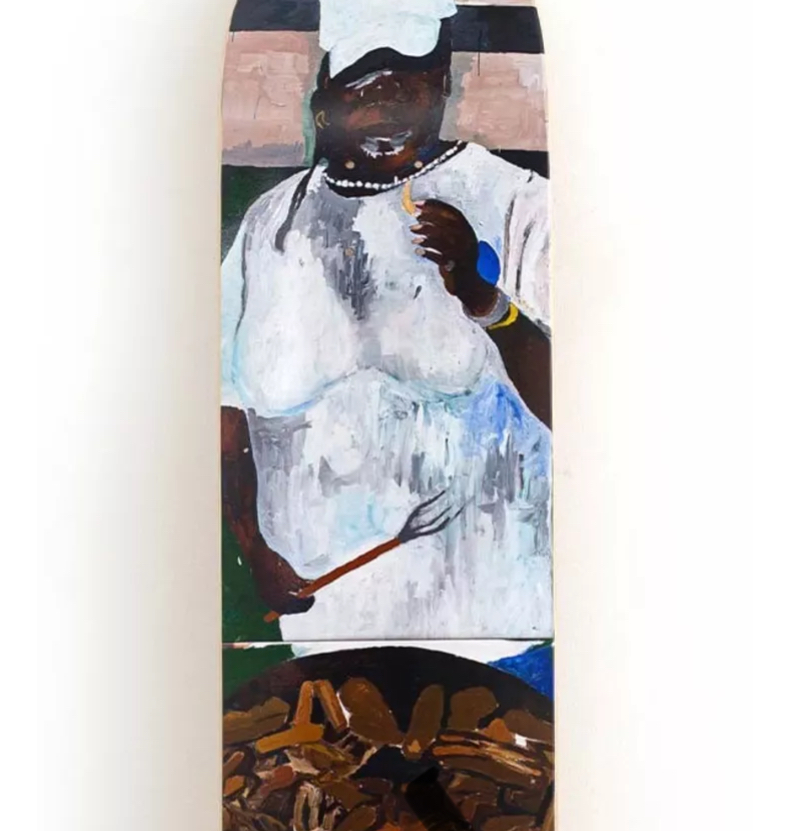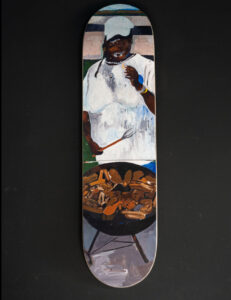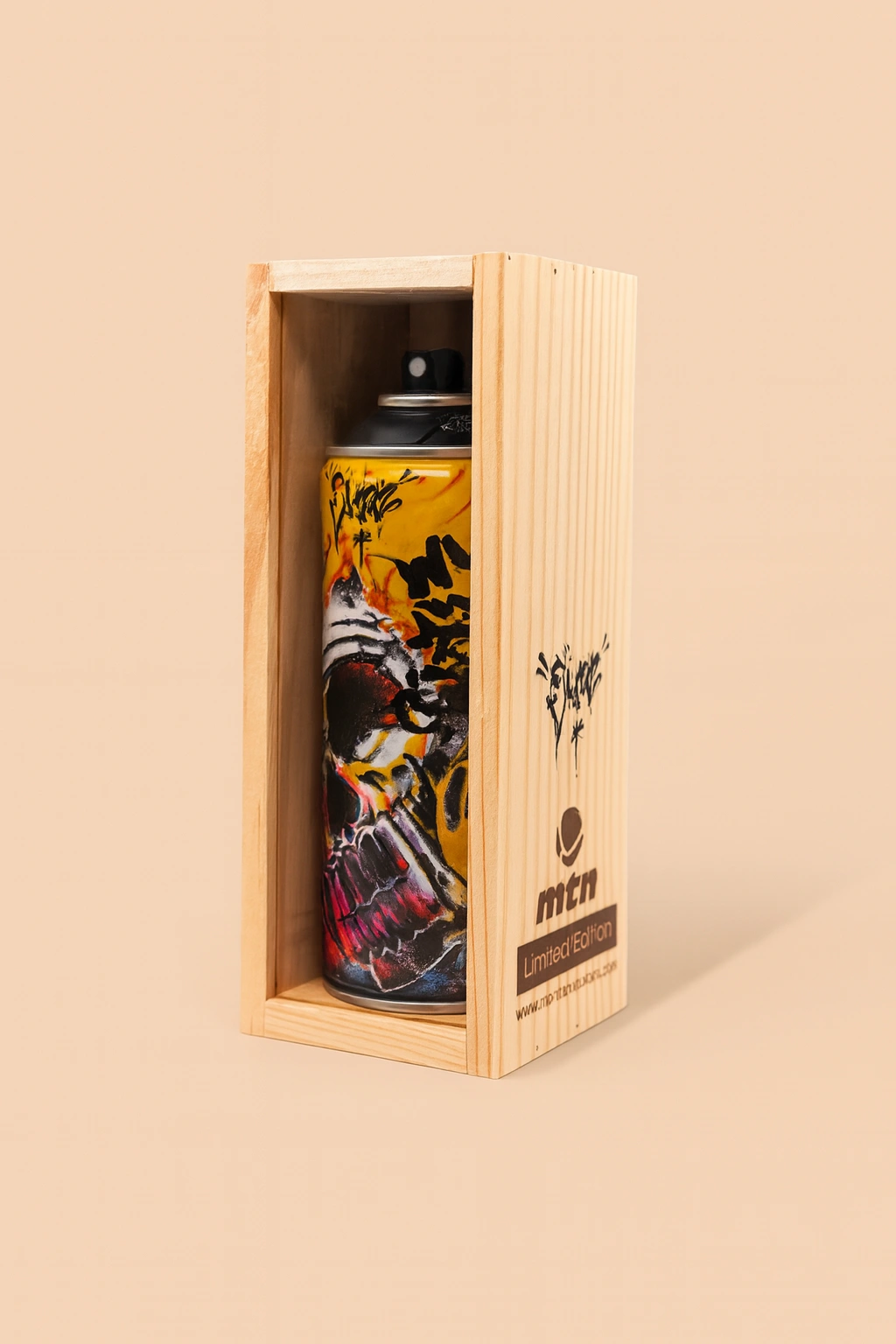Artist: Henry Taylor
Henry Taylor doesn’t make easy art. He doesn’t smooth edges or wrap up stories with clean morals. His work is brutal and loving, intimate and confrontational. It’s also deeply human. Either he’s painting friends, strangers, or figures brutalized by the state, Taylor makes portraits that refuse to look away. In Untitled (The Fourth) (2022)—a set of three skateboard decks printed with a stark and haunting portrait—Taylor brings his visual language into a new medium, fusing fine art with the aesthetics of skateboarding. The result is raw, mobile protest.
This artwork is not just an image transferred onto maple. It’s a shot fired into the mainstream, repurposing the skateboard—a symbol of rebellion, youth, and freedom—as a platform for Black visibility and memory. The title, The Fourth, is a nod to the Fourth of July—but Taylor, as ever, is not here to celebrate. He’s here to question what freedom looks like in a country that continues to fail its Black citizens.
Skateboards and the Street Gallery
To understand the significance of Untitled (The Fourth), you have to consider the skateboard not only as a vehicle but as a canvas—one that moves through public space. Skate decks have long been surfaces for design, graphics, identity. From Powell Peralta’s bones brigade to Supreme’s Duchampian provocations, the deck has evolved into both cultural artifact and gallery-ready object.
But Taylor isn’t co-opting skate culture. His move makes sense. He’s long painted on cardboard boxes, cigarette packs, wooden boards. His art doesn’t stay on the wall. By printing a painful portrait onto skateboards, Taylor breaks down barriers between museum art and everyday life. The decks carry the image into the street, the park, the hands of young skaters. In doing so, the work taps into a different mode of visibility—public, kinetic, restless.
The 7-ply Grade A Canadian maple isn’t just material. It’s symbolic. Strong, flexible, built to endure abuse—just like the bodies and spirits of the people Taylor paints.
The Image: Who Gets Remembered?
The image that spans the three decks is unmistakably Taylor: flat planes, urgent brushstrokes, eyes that follow you. The face is Black, male, somber. It hovers in a void of red, white, and blue—colors of the American flag turned hostile. The figure stares straight ahead, mouth slightly open. He’s not smiling. He’s not posing. He’s enduring.
Taylor doesn’t tell us who this man is. That’s intentional. It could be anyone. It could be you. It could be a stand-in for countless Black lives, remembered and forgotten, claimed and discarded. The anonymity gives the portrait weight. It universalizes the experience while still insisting on presence. This person matters, even if you don’t know his name.
The Fourth of July context sharpens the knife. In America, the Fourth is a national holiday of fireworks and freedom. But for many Black Americans, it’s a day laced with irony. How do you celebrate freedom in a nation built on slavery, segregation, and systemic violence? Taylor forces the viewer to hold that contradiction. He offers no comfort.
The Legacy of Black Portraiture
Taylor is part of a long tradition of Black artists who have used portraiture as a political act. From Charles White’s monumental drawings to Kerry James Marshall’s mythic narratives, the Black body in American art has been a battleground. Taylor paints people who often get left out of the story: mental health patients, unhoused neighbors, victims of police violence.
But unlike some of his peers, Taylor’s style resists perfection. His portraits are fast, raw, emotional. They reject academic polish in favor of urgency. This is not about idealization. It’s about recognition. About recording lives before they disappear.
In Untitled (The Fourth), the use of a disjointed triptych (split across three skateboards) echoes the fragmentation of memory, history, and identity. You can’t take in the whole portrait at once. It demands that you move—literally or metaphorically—to reassemble the image. This act of reassembly mirrors the process of reclaiming Black history: piece by piece, across time, across trauma.
From Museum to Market to Street
Taylor has shown in institutions like the Whitney, the Venice Biennale, MoMA PS1. He’s a critical darling and a market star. But this piece isn’t locked behind glass. It was released in collaboration with The Skateroom, a company that pairs artists with skate decks for social impact. That matters.
Too often, political art gets neutered in the white cube. By putting this image on decks meant to ride, grind, and get wrecked, Taylor resists that. The message doesn’t stay still. It rolls through neighborhoods. It gets scraped. It gets noticed. It lives.
And yet, there’s still tension. The art market loves to commodify rebellion. Limited-edition decks like these can end up on collectors’ walls, not skaters’ feet. So the question remains: is this activism or adornment? Taylor walks that line knowingly. He’s aware of the contradictions. He embraces them. Because the real power of the piece is not in how it’s consumed, but in how it confronts.
The Fourth, Again and Again
Each year, the Fourth of July arrives with the same promise: liberty and justice for all. And each year, that promise rings hollow for many. Taylor’s Untitled (The Fourth) doesn’t just critique that contradiction—it embodies it. The image, spread across functional skate decks, splits the promise of freedom into parts. Freedom isn’t whole. It’s fractured. It rolls over pavement. It gets worn down.
This is not a celebratory work. It’s a lament. A protest. A monument without a pedestal.
And yet, there’s still defiance in the act of portraiture. In a world that erases Black lives, Taylor insists: “Look.” Even if you don’t want to. Even if it’s hard. Especially then.
Art on the Move: A New Kind of Memorial
The portability of Untitled (The Fourth) makes it a unique kind of memorial. It doesn’t sit in a park. It doesn’t wait for approval. It moves. It doesn’t ask for permission to grieve. That’s powerful.
In this way, Taylor aligns himself with artists like David Hammons, who made work on sidewalks, in empty lots, on basketball courts. Like Hammons, Taylor knows that public space is political. That where you put the art matters as much as what’s in it.
And so, a haunting face on a set of decks becomes more than an image. It becomes an act. A call. A reckoning.
Flow
There’s no tidy way to conclude a work like Untitled (The Fourth). That’s the point. The piece resists closure. It asks you to keep thinking, looking, moving. It’s not just about what you see—it’s about what you do after.
Henry Taylor has said: “I’m trying to paint what I see.” What he sees is hard. Painful. But also worth witnessing.
This set of skate decks—simple in form, heavy in message—reminds us that art doesn’t have to sit still to be powerful. Sometimes, it needs to roll. To fall. To resist. And sometimes, it needs to look you in the eye and ask: Whose freedom are you celebrating?
Artwork Details:
- Title: Untitled (The Fourth)
- Artist: Henry Taylor
- Year: 2022
- Medium: Printed skateboard decks (set of three)
- Material: 7-ply Grade A Canadian Maple
- Dimensions: Standard skate deck sizing
- Edition: Limited release via The Skateroom
No comments yet.









